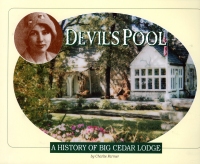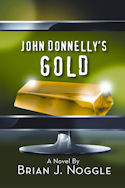 We spent a couple of days down at Big Cedar Lodge, a resort on Table Rock Lake owned by the Bass Pro Shops people, and the gift store had this book. I’m always interested in very localized history offerings, and this book is hyper localized. Whereas Webster Park: 1892-1992, Elm Ave., Heart of Webster, and North Webster: A Photograpic History of a Black Community, this book chronicles two houses.
We spent a couple of days down at Big Cedar Lodge, a resort on Table Rock Lake owned by the Bass Pro Shops people, and the gift store had this book. I’m always interested in very localized history offerings, and this book is hyper localized. Whereas Webster Park: 1892-1992, Elm Ave., Heart of Webster, and North Webster: A Photograpic History of a Black Community, this book chronicles two houses.
Well, a little more than that.
The book starts out with allusions to the Devil’s Pool and its legends, including the story of an Osage named Wah ‘Kon Tah. The section covering this early history of the region is quite nebulous and abstract, as it would have to be. It’s also a bit of an elegy for the beauty of untamed wilderness versus the predations of man who builds stuff on it and ruins it.
The book gets historical when the land is purchased by a pair of fellows, a Worman and a Simmons, who build homes on it for country retreats during Great Depression I. The book looks at the men and their wives for a while and then goes into the sale and transfer of the property until it becomes the Devil’s Pool Dude Ranch in the 1940s. The book includes a number of first hand accounts from those years, but in the 1960s the owner sells it to a man who dies shortly thereafter in an automobile accident. In 1979, a fellow buys it from the Army Corps of Engineers and tries to turn it into a time-share property, but that doesn’t survive. Then the fellow behind Bass Pro Shops bought it and turned it into the excellent resort it is today, which includes some time shares on the property.
So it’s fittingly a short book: although the landscape has been there a while, there’s not a lot of history to report on the property except that people have moved through it. The author plays up the stories of strange apparitions and ghost stuff tarts it up a bit, where some people think that perhaps Mrs. Worman whose ashes were scattered on the property (although she did not die there) might lead to her haunting it. The structure of the book is not straight ahead in timelines, either–sometimes a person is mentioned and gives some account of his or her time there, so it goes beyond where the character was introduced, and after he or she is done speaking, we go back to the time period where he or she is introduced. That could have been smoothed out.
This piece ultimately reads as a for-hire piece, a sort of white paper for the lodge itself. Which is okay, but it’s not a grand historical document.
And let’s be honest: The one bit of history I’d like to know about is what happened to the purchasers of the time share from the 1980s when the Bass Pro people bought it. Because I just bought a time share in it, and I was assured by the 20 year old sales closer guy that we’re covered in the case of the company reorganizing. And I don’t believe him.
Books mentioned in this review:


